Lead Mining in Queensland: A Study of Mount Isa Mines
VerifiedAdded on 2023/06/03
|14
|3433
|244
AI Summary
This report focuses on lead mining in Queensland, specifically at Mount Isa Mines. It covers the history of lead mining in Australia, the properties of lead, the mining methods applied, and the processing of ore. It also discusses the impacts of lead mining on the environment, health, and society, as well as the economic benefits. The report concludes with a discussion of the real and lasting impacts of lead mining on the Mount Isa area.
Contribute Materials
Your contribution can guide someone’s learning journey. Share your
documents today.
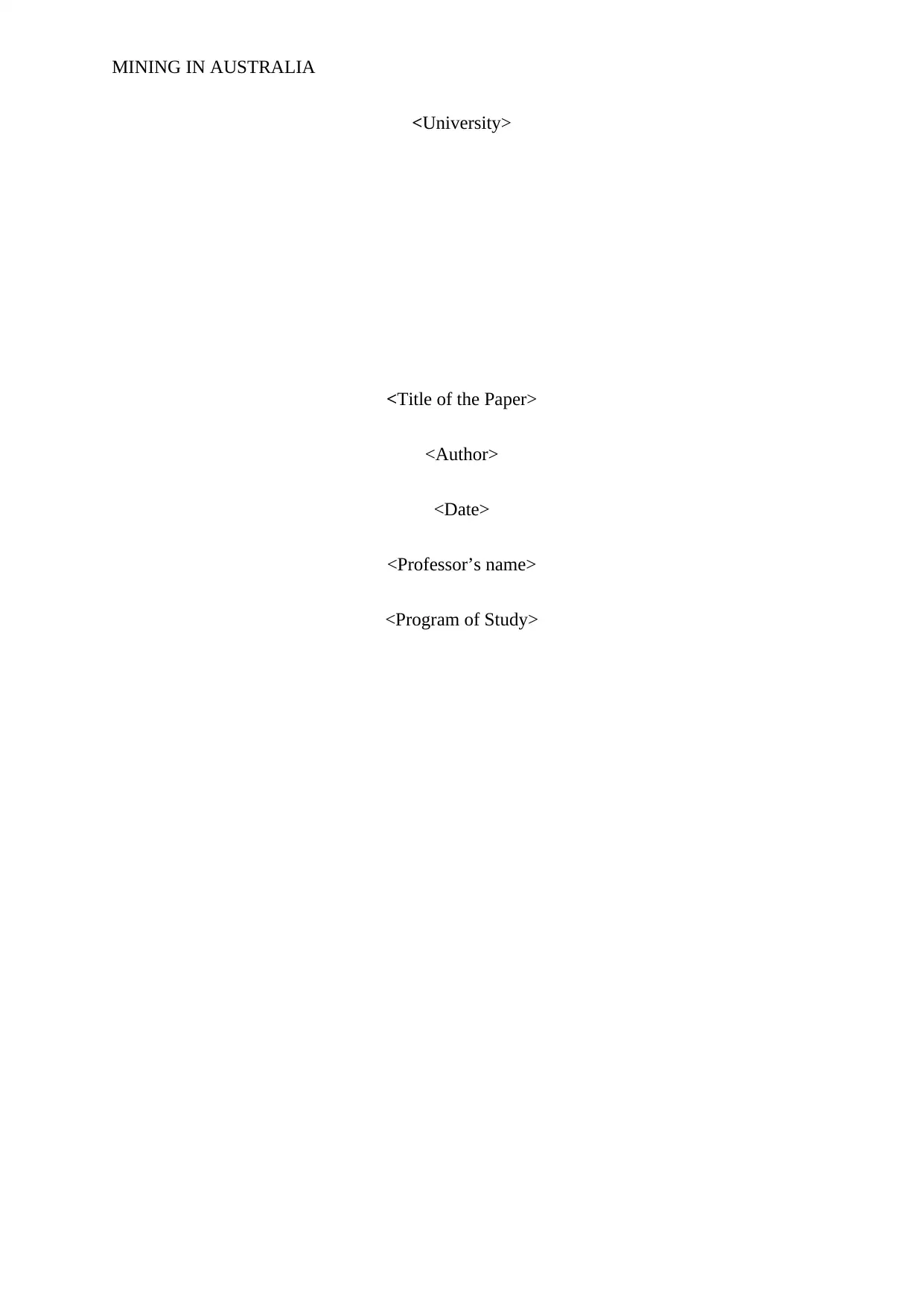
MINING IN AUSTRALIA
<University>
<Title of the Paper>
<Author>
<Date>
<Professor’s name>
<Program of Study>
<University>
<Title of the Paper>
<Author>
<Date>
<Professor’s name>
<Program of Study>
Secure Best Marks with AI Grader
Need help grading? Try our AI Grader for instant feedback on your assignments.
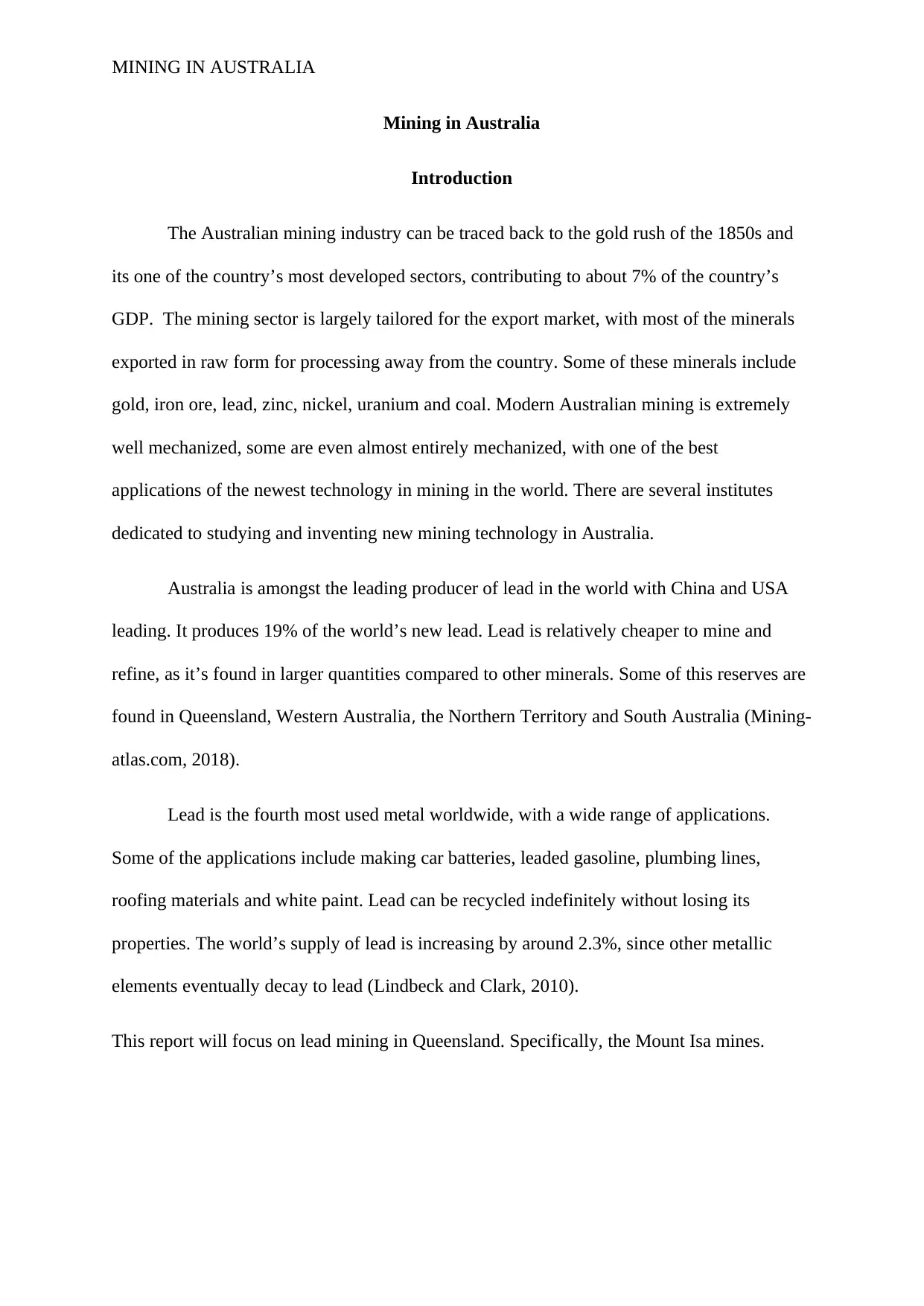
MINING IN AUSTRALIA
Mining in Australia
Introduction
The Australian mining industry can be traced back to the gold rush of the 1850s and
its one of the country’s most developed sectors, contributing to about 7% of the country’s
GDP. The mining sector is largely tailored for the export market, with most of the minerals
exported in raw form for processing away from the country. Some of these minerals include
gold, iron ore, lead, zinc, nickel, uranium and coal. Modern Australian mining is extremely
well mechanized, some are even almost entirely mechanized, with one of the best
applications of the newest technology in mining in the world. There are several institutes
dedicated to studying and inventing new mining technology in Australia.
Australia is amongst the leading producer of lead in the world with China and USA
leading. It produces 19% of the world’s new lead. Lead is relatively cheaper to mine and
refine, as it’s found in larger quantities compared to other minerals. Some of this reserves are
found in Queensland, Western Australia, the Northern Territory and South Australia (Mining-
atlas.com, 2018).
Lead is the fourth most used metal worldwide, with a wide range of applications.
Some of the applications include making car batteries, leaded gasoline, plumbing lines,
roofing materials and white paint. Lead can be recycled indefinitely without losing its
properties. The world’s supply of lead is increasing by around 2.3%, since other metallic
elements eventually decay to lead (Lindbeck and Clark, 2010).
This report will focus on lead mining in Queensland. Specifically, the Mount Isa mines.
Mining in Australia
Introduction
The Australian mining industry can be traced back to the gold rush of the 1850s and
its one of the country’s most developed sectors, contributing to about 7% of the country’s
GDP. The mining sector is largely tailored for the export market, with most of the minerals
exported in raw form for processing away from the country. Some of these minerals include
gold, iron ore, lead, zinc, nickel, uranium and coal. Modern Australian mining is extremely
well mechanized, some are even almost entirely mechanized, with one of the best
applications of the newest technology in mining in the world. There are several institutes
dedicated to studying and inventing new mining technology in Australia.
Australia is amongst the leading producer of lead in the world with China and USA
leading. It produces 19% of the world’s new lead. Lead is relatively cheaper to mine and
refine, as it’s found in larger quantities compared to other minerals. Some of this reserves are
found in Queensland, Western Australia, the Northern Territory and South Australia (Mining-
atlas.com, 2018).
Lead is the fourth most used metal worldwide, with a wide range of applications.
Some of the applications include making car batteries, leaded gasoline, plumbing lines,
roofing materials and white paint. Lead can be recycled indefinitely without losing its
properties. The world’s supply of lead is increasing by around 2.3%, since other metallic
elements eventually decay to lead (Lindbeck and Clark, 2010).
This report will focus on lead mining in Queensland. Specifically, the Mount Isa mines.
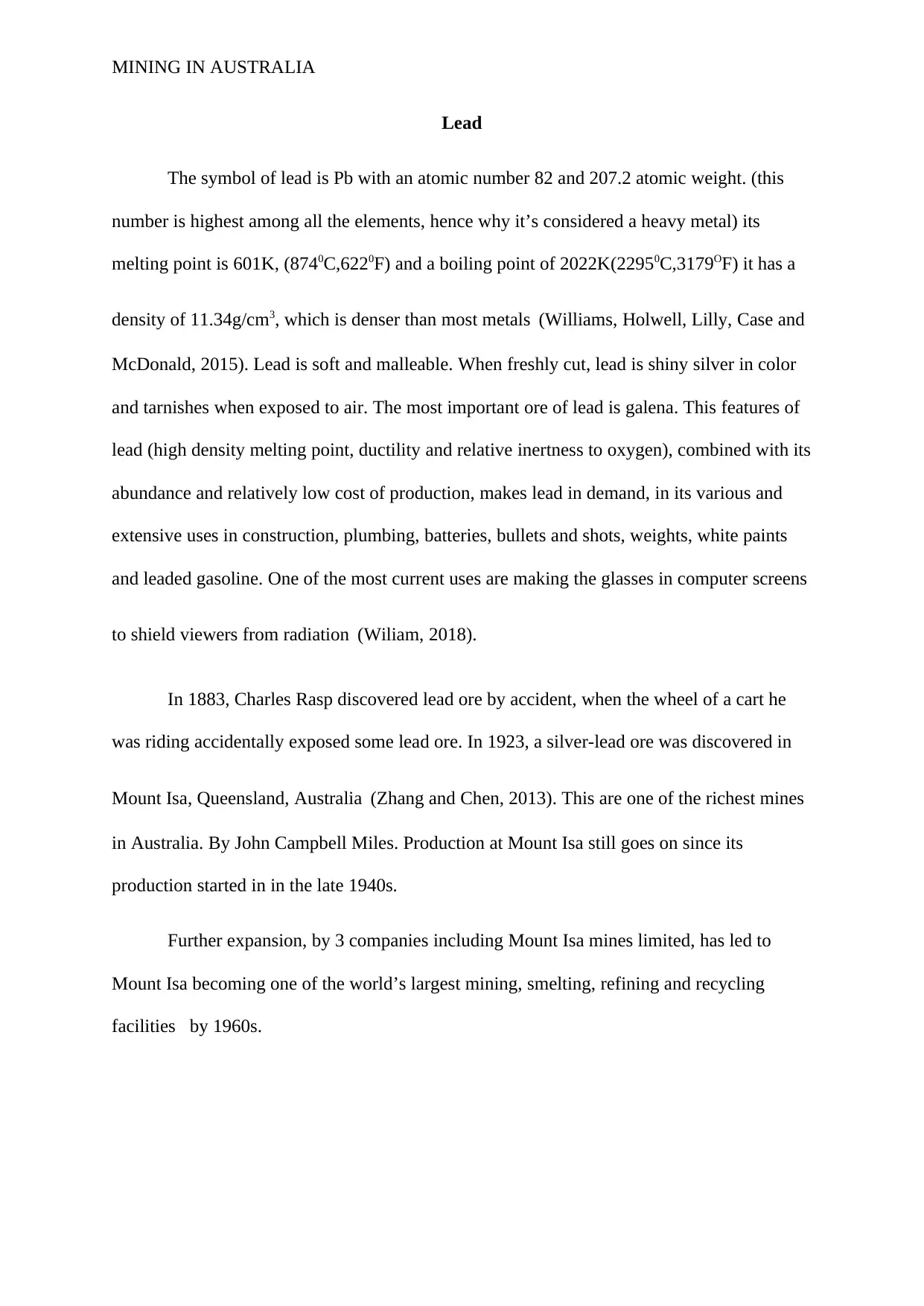
MINING IN AUSTRALIA
Lead
The symbol of lead is Pb with an atomic number 82 and 207.2 atomic weight. (this
number is highest among all the elements, hence why it’s considered a heavy metal) its
melting point is 601K, (8740C,6220F) and a boiling point of 2022K(22950C,3179OF) it has a
density of 11.34g/cm3, which is denser than most metals (Williams, Holwell, Lilly, Case and
McDonald, 2015). Lead is soft and malleable. When freshly cut, lead is shiny silver in color
and tarnishes when exposed to air. The most important ore of lead is galena. This features of
lead (high density melting point, ductility and relative inertness to oxygen), combined with its
abundance and relatively low cost of production, makes lead in demand, in its various and
extensive uses in construction, plumbing, batteries, bullets and shots, weights, white paints
and leaded gasoline. One of the most current uses are making the glasses in computer screens
to shield viewers from radiation (Wiliam, 2018).
In 1883, Charles Rasp discovered lead ore by accident, when the wheel of a cart he
was riding accidentally exposed some lead ore. In 1923, a silver-lead ore was discovered in
Mount Isa, Queensland, Australia (Zhang and Chen, 2013). This are one of the richest mines
in Australia. By John Campbell Miles. Production at Mount Isa still goes on since its
production started in in the late 1940s.
Further expansion, by 3 companies including Mount Isa mines limited, has led to
Mount Isa becoming one of the world’s largest mining, smelting, refining and recycling
facilities by 1960s.
Lead
The symbol of lead is Pb with an atomic number 82 and 207.2 atomic weight. (this
number is highest among all the elements, hence why it’s considered a heavy metal) its
melting point is 601K, (8740C,6220F) and a boiling point of 2022K(22950C,3179OF) it has a
density of 11.34g/cm3, which is denser than most metals (Williams, Holwell, Lilly, Case and
McDonald, 2015). Lead is soft and malleable. When freshly cut, lead is shiny silver in color
and tarnishes when exposed to air. The most important ore of lead is galena. This features of
lead (high density melting point, ductility and relative inertness to oxygen), combined with its
abundance and relatively low cost of production, makes lead in demand, in its various and
extensive uses in construction, plumbing, batteries, bullets and shots, weights, white paints
and leaded gasoline. One of the most current uses are making the glasses in computer screens
to shield viewers from radiation (Wiliam, 2018).
In 1883, Charles Rasp discovered lead ore by accident, when the wheel of a cart he
was riding accidentally exposed some lead ore. In 1923, a silver-lead ore was discovered in
Mount Isa, Queensland, Australia (Zhang and Chen, 2013). This are one of the richest mines
in Australia. By John Campbell Miles. Production at Mount Isa still goes on since its
production started in in the late 1940s.
Further expansion, by 3 companies including Mount Isa mines limited, has led to
Mount Isa becoming one of the world’s largest mining, smelting, refining and recycling
facilities by 1960s.
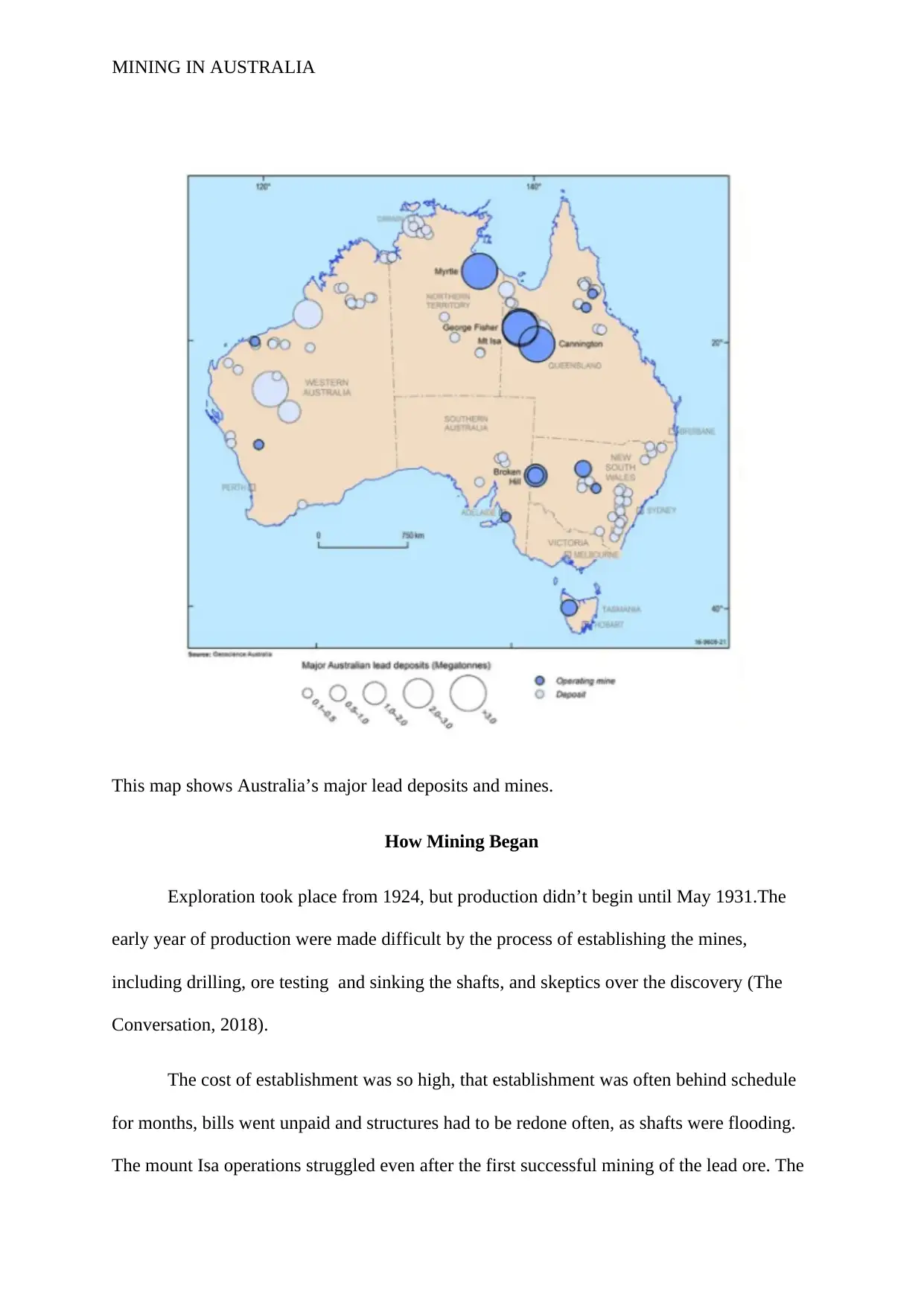
MINING IN AUSTRALIA
This map shows Australia’s major lead deposits and mines.
How Mining Began
Exploration took place from 1924, but production didn’t begin until May 1931.The
early year of production were made difficult by the process of establishing the mines,
including drilling, ore testing and sinking the shafts, and skeptics over the discovery (The
Conversation, 2018).
The cost of establishment was so high, that establishment was often behind schedule
for months, bills went unpaid and structures had to be redone often, as shafts were flooding.
The mount Isa operations struggled even after the first successful mining of the lead ore. The
This map shows Australia’s major lead deposits and mines.
How Mining Began
Exploration took place from 1924, but production didn’t begin until May 1931.The
early year of production were made difficult by the process of establishing the mines,
including drilling, ore testing and sinking the shafts, and skeptics over the discovery (The
Conversation, 2018).
The cost of establishment was so high, that establishment was often behind schedule
for months, bills went unpaid and structures had to be redone often, as shafts were flooding.
The mount Isa operations struggled even after the first successful mining of the lead ore. The
Secure Best Marks with AI Grader
Need help grading? Try our AI Grader for instant feedback on your assignments.
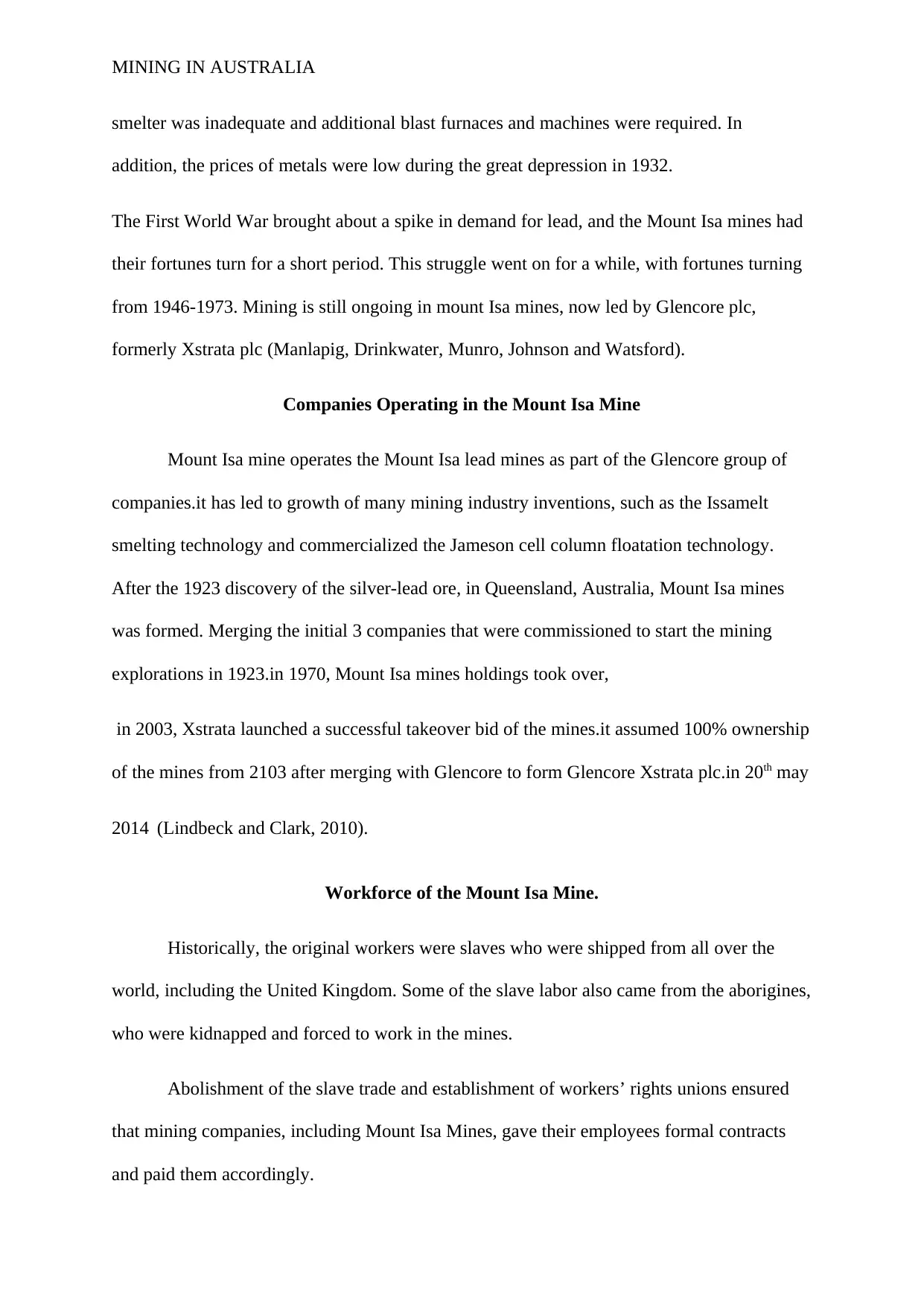
MINING IN AUSTRALIA
smelter was inadequate and additional blast furnaces and machines were required. In
addition, the prices of metals were low during the great depression in 1932.
The First World War brought about a spike in demand for lead, and the Mount Isa mines had
their fortunes turn for a short period. This struggle went on for a while, with fortunes turning
from 1946-1973. Mining is still ongoing in mount Isa mines, now led by Glencore plc,
formerly Xstrata plc (Manlapig, Drinkwater, Munro, Johnson and Watsford).
Companies Operating in the Mount Isa Mine
Mount Isa mine operates the Mount Isa lead mines as part of the Glencore group of
companies.it has led to growth of many mining industry inventions, such as the Issamelt
smelting technology and commercialized the Jameson cell column floatation technology.
After the 1923 discovery of the silver-lead ore, in Queensland, Australia, Mount Isa mines
was formed. Merging the initial 3 companies that were commissioned to start the mining
explorations in 1923.in 1970, Mount Isa mines holdings took over,
in 2003, Xstrata launched a successful takeover bid of the mines.it assumed 100% ownership
of the mines from 2103 after merging with Glencore to form Glencore Xstrata plc.in 20th may
2014 (Lindbeck and Clark, 2010).
Workforce of the Mount Isa Mine.
Historically, the original workers were slaves who were shipped from all over the
world, including the United Kingdom. Some of the slave labor also came from the aborigines,
who were kidnapped and forced to work in the mines.
Abolishment of the slave trade and establishment of workers’ rights unions ensured
that mining companies, including Mount Isa Mines, gave their employees formal contracts
and paid them accordingly.
smelter was inadequate and additional blast furnaces and machines were required. In
addition, the prices of metals were low during the great depression in 1932.
The First World War brought about a spike in demand for lead, and the Mount Isa mines had
their fortunes turn for a short period. This struggle went on for a while, with fortunes turning
from 1946-1973. Mining is still ongoing in mount Isa mines, now led by Glencore plc,
formerly Xstrata plc (Manlapig, Drinkwater, Munro, Johnson and Watsford).
Companies Operating in the Mount Isa Mine
Mount Isa mine operates the Mount Isa lead mines as part of the Glencore group of
companies.it has led to growth of many mining industry inventions, such as the Issamelt
smelting technology and commercialized the Jameson cell column floatation technology.
After the 1923 discovery of the silver-lead ore, in Queensland, Australia, Mount Isa mines
was formed. Merging the initial 3 companies that were commissioned to start the mining
explorations in 1923.in 1970, Mount Isa mines holdings took over,
in 2003, Xstrata launched a successful takeover bid of the mines.it assumed 100% ownership
of the mines from 2103 after merging with Glencore to form Glencore Xstrata plc.in 20th may
2014 (Lindbeck and Clark, 2010).
Workforce of the Mount Isa Mine.
Historically, the original workers were slaves who were shipped from all over the
world, including the United Kingdom. Some of the slave labor also came from the aborigines,
who were kidnapped and forced to work in the mines.
Abolishment of the slave trade and establishment of workers’ rights unions ensured
that mining companies, including Mount Isa Mines, gave their employees formal contracts
and paid them accordingly.
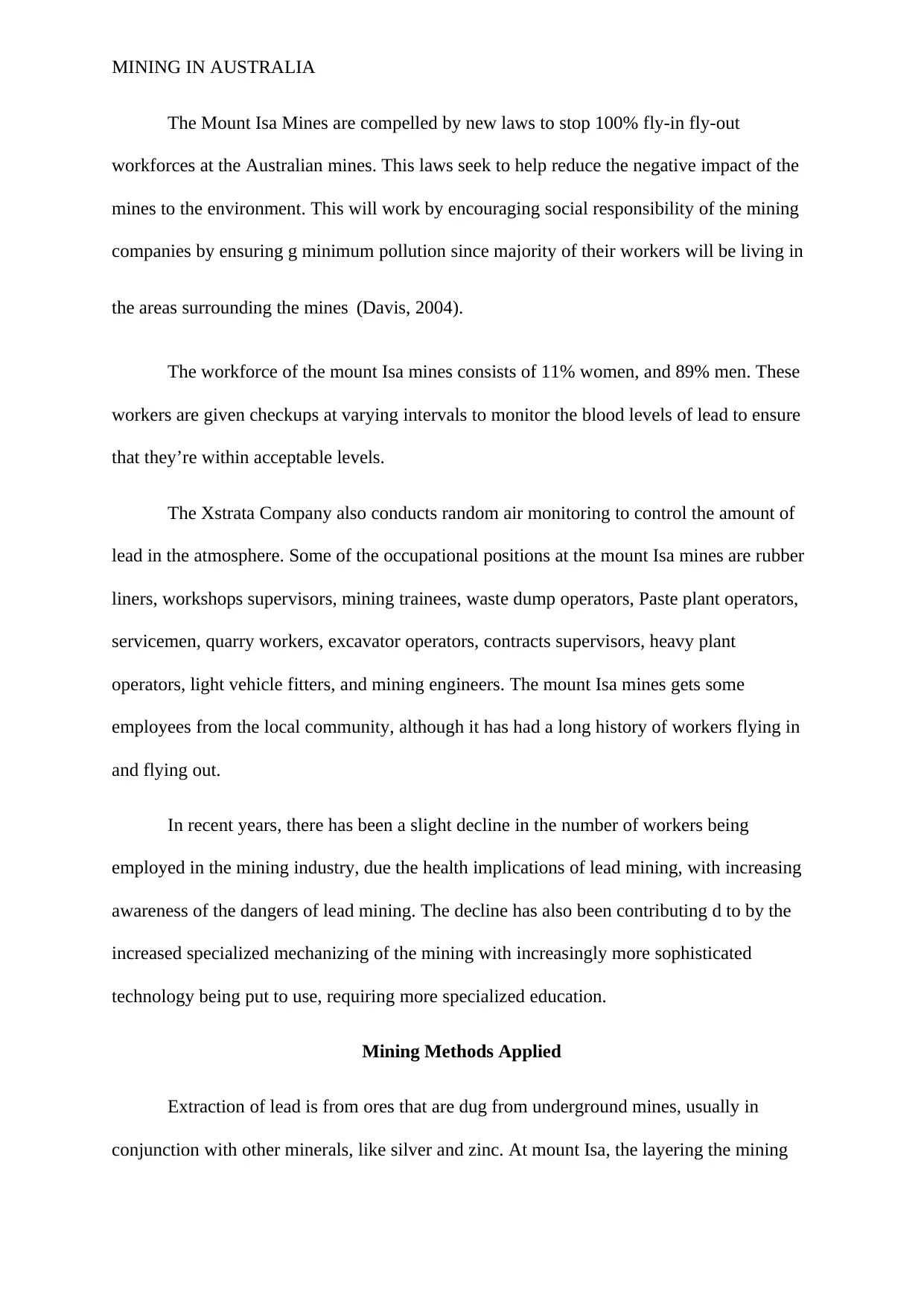
MINING IN AUSTRALIA
The Mount Isa Mines are compelled by new laws to stop 100% fly-in fly-out
workforces at the Australian mines. This laws seek to help reduce the negative impact of the
mines to the environment. This will work by encouraging social responsibility of the mining
companies by ensuring g minimum pollution since majority of their workers will be living in
the areas surrounding the mines (Davis, 2004).
The workforce of the mount Isa mines consists of 11% women, and 89% men. These
workers are given checkups at varying intervals to monitor the blood levels of lead to ensure
that they’re within acceptable levels.
The Xstrata Company also conducts random air monitoring to control the amount of
lead in the atmosphere. Some of the occupational positions at the mount Isa mines are rubber
liners, workshops supervisors, mining trainees, waste dump operators, Paste plant operators,
servicemen, quarry workers, excavator operators, contracts supervisors, heavy plant
operators, light vehicle fitters, and mining engineers. The mount Isa mines gets some
employees from the local community, although it has had a long history of workers flying in
and flying out.
In recent years, there has been a slight decline in the number of workers being
employed in the mining industry, due the health implications of lead mining, with increasing
awareness of the dangers of lead mining. The decline has also been contributing d to by the
increased specialized mechanizing of the mining with increasingly more sophisticated
technology being put to use, requiring more specialized education.
Mining Methods Applied
Extraction of lead is from ores that are dug from underground mines, usually in
conjunction with other minerals, like silver and zinc. At mount Isa, the layering the mining
The Mount Isa Mines are compelled by new laws to stop 100% fly-in fly-out
workforces at the Australian mines. This laws seek to help reduce the negative impact of the
mines to the environment. This will work by encouraging social responsibility of the mining
companies by ensuring g minimum pollution since majority of their workers will be living in
the areas surrounding the mines (Davis, 2004).
The workforce of the mount Isa mines consists of 11% women, and 89% men. These
workers are given checkups at varying intervals to monitor the blood levels of lead to ensure
that they’re within acceptable levels.
The Xstrata Company also conducts random air monitoring to control the amount of
lead in the atmosphere. Some of the occupational positions at the mount Isa mines are rubber
liners, workshops supervisors, mining trainees, waste dump operators, Paste plant operators,
servicemen, quarry workers, excavator operators, contracts supervisors, heavy plant
operators, light vehicle fitters, and mining engineers. The mount Isa mines gets some
employees from the local community, although it has had a long history of workers flying in
and flying out.
In recent years, there has been a slight decline in the number of workers being
employed in the mining industry, due the health implications of lead mining, with increasing
awareness of the dangers of lead mining. The decline has also been contributing d to by the
increased specialized mechanizing of the mining with increasingly more sophisticated
technology being put to use, requiring more specialized education.
Mining Methods Applied
Extraction of lead is from ores that are dug from underground mines, usually in
conjunction with other minerals, like silver and zinc. At mount Isa, the layering the mining
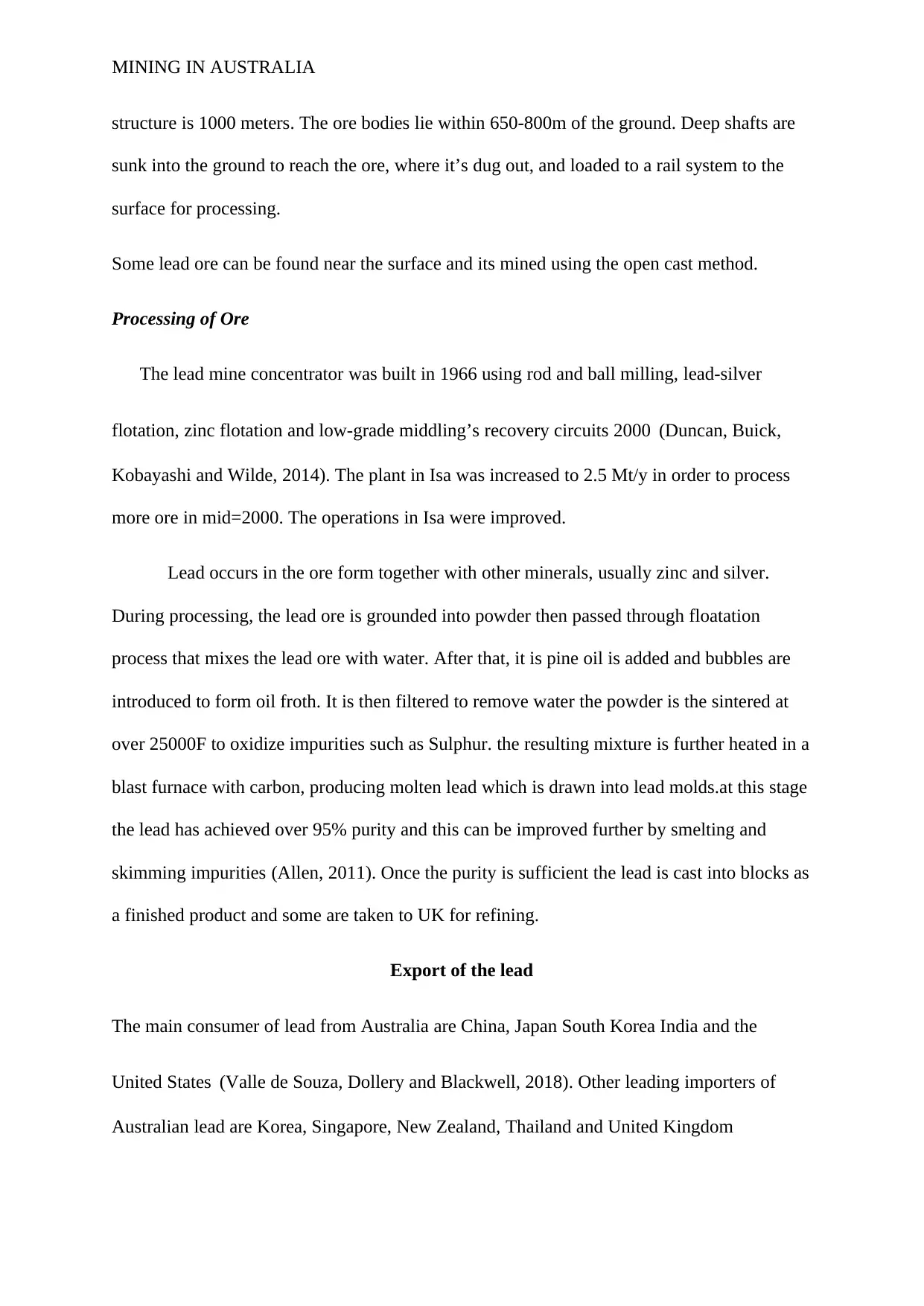
MINING IN AUSTRALIA
structure is 1000 meters. The ore bodies lie within 650-800m of the ground. Deep shafts are
sunk into the ground to reach the ore, where it’s dug out, and loaded to a rail system to the
surface for processing.
Some lead ore can be found near the surface and its mined using the open cast method.
Processing of Ore
The lead mine concentrator was built in 1966 using rod and ball milling, lead-silver
flotation, zinc flotation and low-grade middling’s recovery circuits 2000 (Duncan, Buick,
Kobayashi and Wilde, 2014). The plant in Isa was increased to 2.5 Mt/y in order to process
more ore in mid=2000. The operations in Isa were improved.
Lead occurs in the ore form together with other minerals, usually zinc and silver.
During processing, the lead ore is grounded into powder then passed through floatation
process that mixes the lead ore with water. After that, it is pine oil is added and bubbles are
introduced to form oil froth. It is then filtered to remove water the powder is the sintered at
over 25000F to oxidize impurities such as Sulphur. the resulting mixture is further heated in a
blast furnace with carbon, producing molten lead which is drawn into lead molds.at this stage
the lead has achieved over 95% purity and this can be improved further by smelting and
skimming impurities (Allen, 2011). Once the purity is sufficient the lead is cast into blocks as
a finished product and some are taken to UK for refining.
Export of the lead
The main consumer of lead from Australia are China, Japan South Korea India and the
United States (Valle de Souza, Dollery and Blackwell, 2018). Other leading importers of
Australian lead are Korea, Singapore, New Zealand, Thailand and United Kingdom
structure is 1000 meters. The ore bodies lie within 650-800m of the ground. Deep shafts are
sunk into the ground to reach the ore, where it’s dug out, and loaded to a rail system to the
surface for processing.
Some lead ore can be found near the surface and its mined using the open cast method.
Processing of Ore
The lead mine concentrator was built in 1966 using rod and ball milling, lead-silver
flotation, zinc flotation and low-grade middling’s recovery circuits 2000 (Duncan, Buick,
Kobayashi and Wilde, 2014). The plant in Isa was increased to 2.5 Mt/y in order to process
more ore in mid=2000. The operations in Isa were improved.
Lead occurs in the ore form together with other minerals, usually zinc and silver.
During processing, the lead ore is grounded into powder then passed through floatation
process that mixes the lead ore with water. After that, it is pine oil is added and bubbles are
introduced to form oil froth. It is then filtered to remove water the powder is the sintered at
over 25000F to oxidize impurities such as Sulphur. the resulting mixture is further heated in a
blast furnace with carbon, producing molten lead which is drawn into lead molds.at this stage
the lead has achieved over 95% purity and this can be improved further by smelting and
skimming impurities (Allen, 2011). Once the purity is sufficient the lead is cast into blocks as
a finished product and some are taken to UK for refining.
Export of the lead
The main consumer of lead from Australia are China, Japan South Korea India and the
United States (Valle de Souza, Dollery and Blackwell, 2018). Other leading importers of
Australian lead are Korea, Singapore, New Zealand, Thailand and United Kingdom
Paraphrase This Document
Need a fresh take? Get an instant paraphrase of this document with our AI Paraphraser
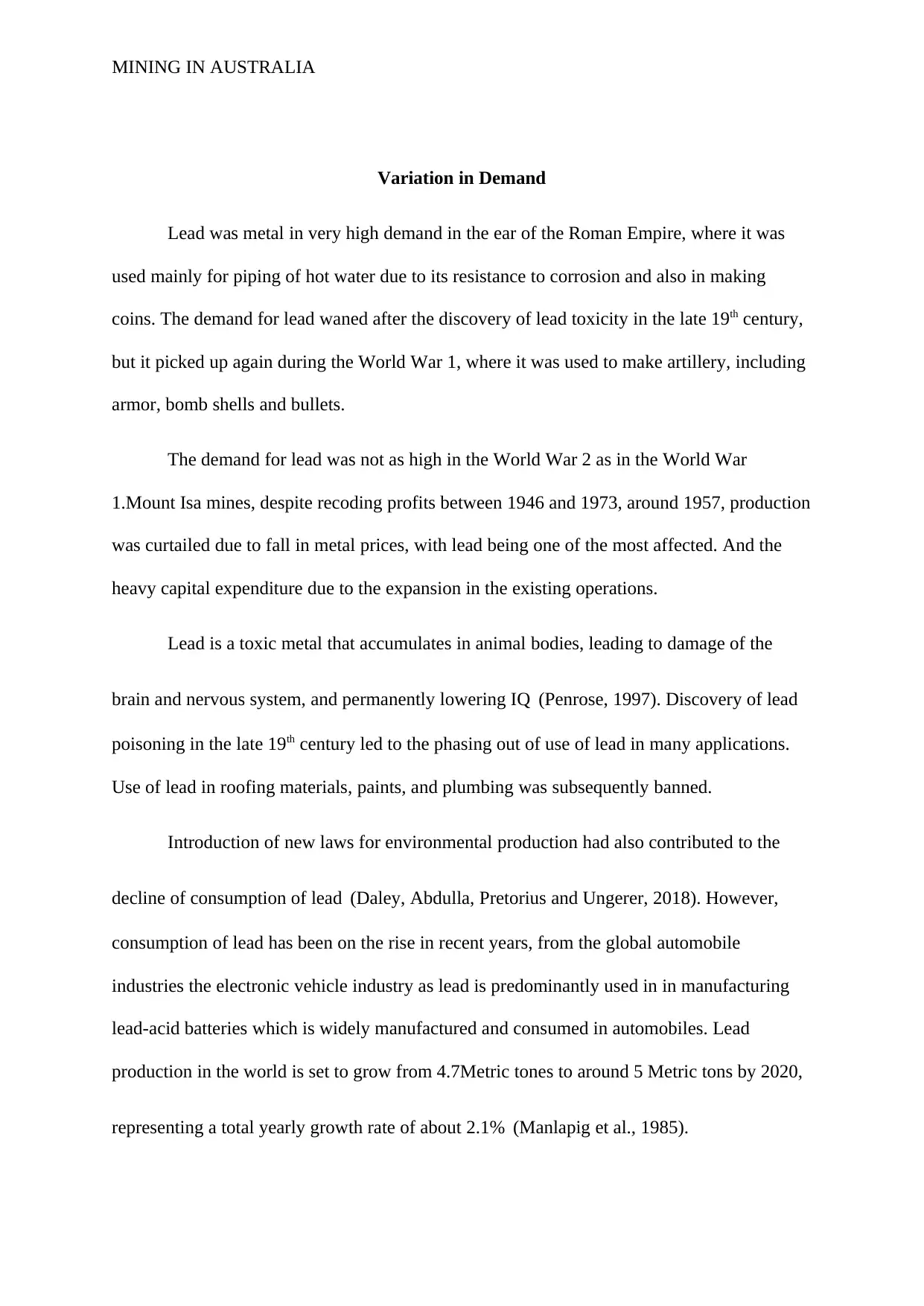
MINING IN AUSTRALIA
Variation in Demand
Lead was metal in very high demand in the ear of the Roman Empire, where it was
used mainly for piping of hot water due to its resistance to corrosion and also in making
coins. The demand for lead waned after the discovery of lead toxicity in the late 19th century,
but it picked up again during the World War 1, where it was used to make artillery, including
armor, bomb shells and bullets.
The demand for lead was not as high in the World War 2 as in the World War
1.Mount Isa mines, despite recoding profits between 1946 and 1973, around 1957, production
was curtailed due to fall in metal prices, with lead being one of the most affected. And the
heavy capital expenditure due to the expansion in the existing operations.
Lead is a toxic metal that accumulates in animal bodies, leading to damage of the
brain and nervous system, and permanently lowering IQ (Penrose, 1997). Discovery of lead
poisoning in the late 19th century led to the phasing out of use of lead in many applications.
Use of lead in roofing materials, paints, and plumbing was subsequently banned.
Introduction of new laws for environmental production had also contributed to the
decline of consumption of lead (Daley, Abdulla, Pretorius and Ungerer, 2018). However,
consumption of lead has been on the rise in recent years, from the global automobile
industries the electronic vehicle industry as lead is predominantly used in in manufacturing
lead-acid batteries which is widely manufactured and consumed in automobiles. Lead
production in the world is set to grow from 4.7Metric tones to around 5 Metric tons by 2020,
representing a total yearly growth rate of about 2.1% (Manlapig et al., 1985).
Variation in Demand
Lead was metal in very high demand in the ear of the Roman Empire, where it was
used mainly for piping of hot water due to its resistance to corrosion and also in making
coins. The demand for lead waned after the discovery of lead toxicity in the late 19th century,
but it picked up again during the World War 1, where it was used to make artillery, including
armor, bomb shells and bullets.
The demand for lead was not as high in the World War 2 as in the World War
1.Mount Isa mines, despite recoding profits between 1946 and 1973, around 1957, production
was curtailed due to fall in metal prices, with lead being one of the most affected. And the
heavy capital expenditure due to the expansion in the existing operations.
Lead is a toxic metal that accumulates in animal bodies, leading to damage of the
brain and nervous system, and permanently lowering IQ (Penrose, 1997). Discovery of lead
poisoning in the late 19th century led to the phasing out of use of lead in many applications.
Use of lead in roofing materials, paints, and plumbing was subsequently banned.
Introduction of new laws for environmental production had also contributed to the
decline of consumption of lead (Daley, Abdulla, Pretorius and Ungerer, 2018). However,
consumption of lead has been on the rise in recent years, from the global automobile
industries the electronic vehicle industry as lead is predominantly used in in manufacturing
lead-acid batteries which is widely manufactured and consumed in automobiles. Lead
production in the world is set to grow from 4.7Metric tones to around 5 Metric tons by 2020,
representing a total yearly growth rate of about 2.1% (Manlapig et al., 1985).
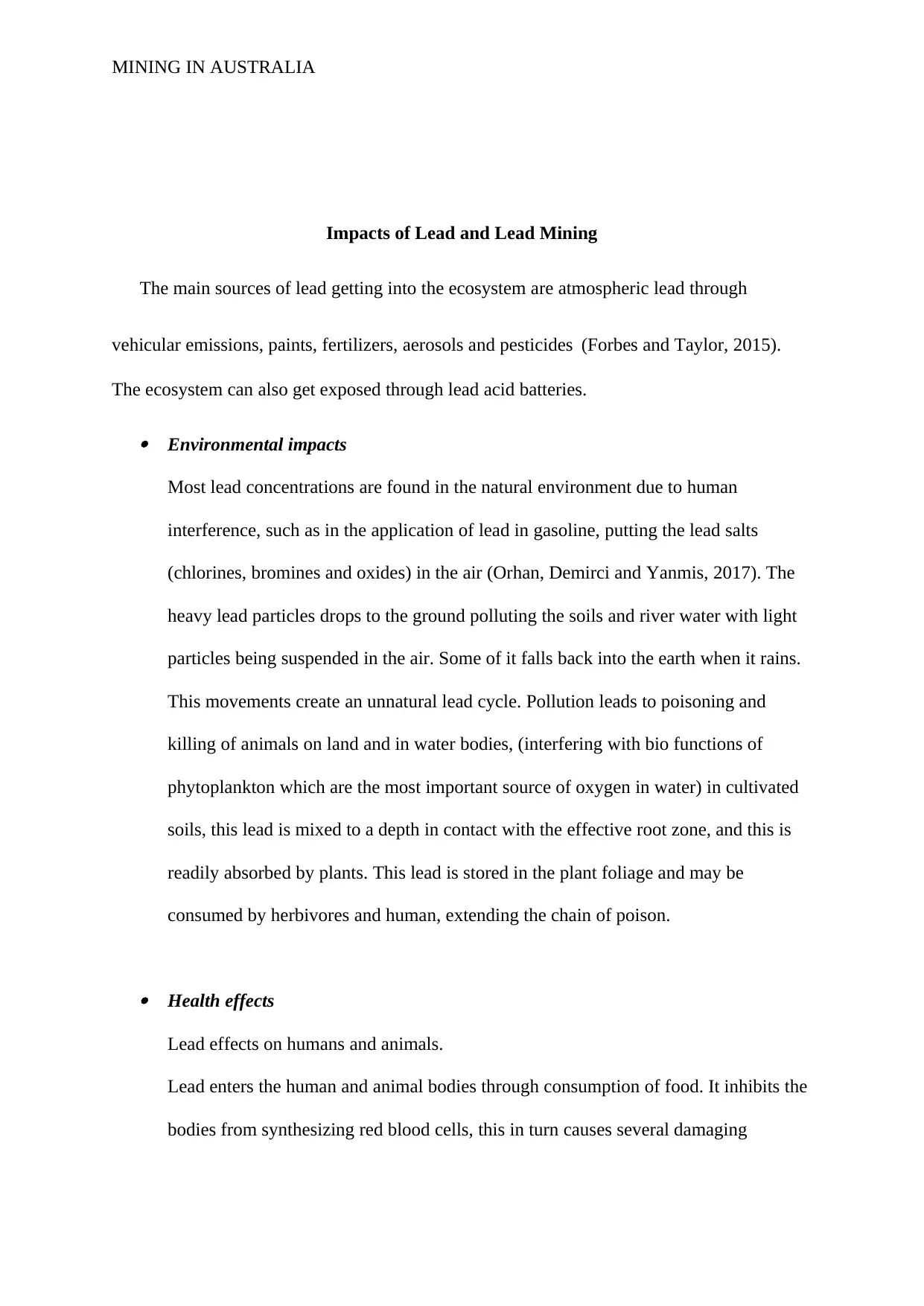
MINING IN AUSTRALIA
Impacts of Lead and Lead Mining
The main sources of lead getting into the ecosystem are atmospheric lead through
vehicular emissions, paints, fertilizers, aerosols and pesticides (Forbes and Taylor, 2015).
The ecosystem can also get exposed through lead acid batteries.
Environmental impacts
Most lead concentrations are found in the natural environment due to human
interference, such as in the application of lead in gasoline, putting the lead salts
(chlorines, bromines and oxides) in the air (Orhan, Demirci and Yanmis, 2017). The
heavy lead particles drops to the ground polluting the soils and river water with light
particles being suspended in the air. Some of it falls back into the earth when it rains.
This movements create an unnatural lead cycle. Pollution leads to poisoning and
killing of animals on land and in water bodies, (interfering with bio functions of
phytoplankton which are the most important source of oxygen in water) in cultivated
soils, this lead is mixed to a depth in contact with the effective root zone, and this is
readily absorbed by plants. This lead is stored in the plant foliage and may be
consumed by herbivores and human, extending the chain of poison.
Health effects
Lead effects on humans and animals.
Lead enters the human and animal bodies through consumption of food. It inhibits the
bodies from synthesizing red blood cells, this in turn causes several damaging
Impacts of Lead and Lead Mining
The main sources of lead getting into the ecosystem are atmospheric lead through
vehicular emissions, paints, fertilizers, aerosols and pesticides (Forbes and Taylor, 2015).
The ecosystem can also get exposed through lead acid batteries.
Environmental impacts
Most lead concentrations are found in the natural environment due to human
interference, such as in the application of lead in gasoline, putting the lead salts
(chlorines, bromines and oxides) in the air (Orhan, Demirci and Yanmis, 2017). The
heavy lead particles drops to the ground polluting the soils and river water with light
particles being suspended in the air. Some of it falls back into the earth when it rains.
This movements create an unnatural lead cycle. Pollution leads to poisoning and
killing of animals on land and in water bodies, (interfering with bio functions of
phytoplankton which are the most important source of oxygen in water) in cultivated
soils, this lead is mixed to a depth in contact with the effective root zone, and this is
readily absorbed by plants. This lead is stored in the plant foliage and may be
consumed by herbivores and human, extending the chain of poison.
Health effects
Lead effects on humans and animals.
Lead enters the human and animal bodies through consumption of food. It inhibits the
bodies from synthesizing red blood cells, this in turn causes several damaging
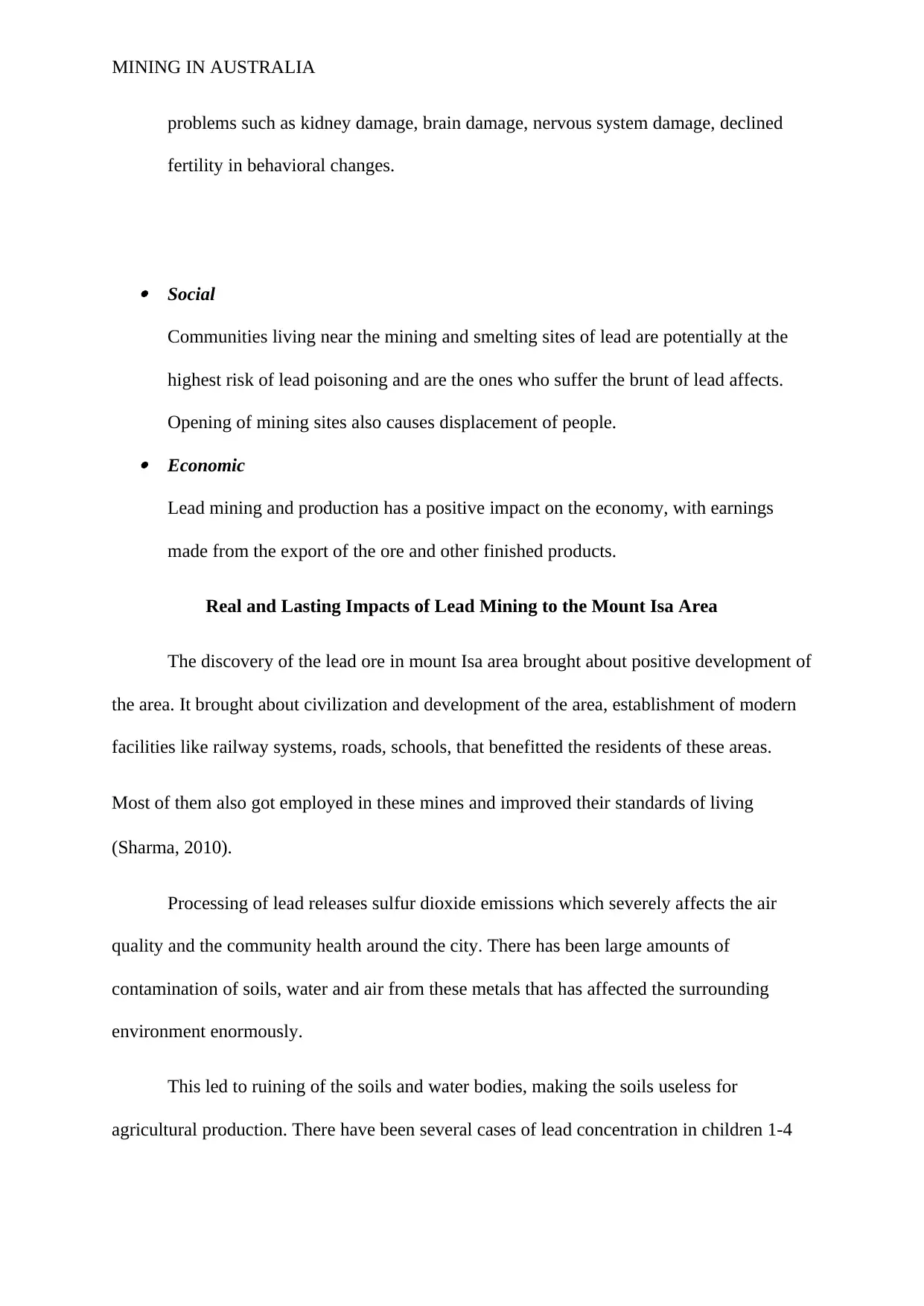
MINING IN AUSTRALIA
problems such as kidney damage, brain damage, nervous system damage, declined
fertility in behavioral changes.
Social
Communities living near the mining and smelting sites of lead are potentially at the
highest risk of lead poisoning and are the ones who suffer the brunt of lead affects.
Opening of mining sites also causes displacement of people. Economic
Lead mining and production has a positive impact on the economy, with earnings
made from the export of the ore and other finished products.
Real and Lasting Impacts of Lead Mining to the Mount Isa Area
The discovery of the lead ore in mount Isa area brought about positive development of
the area. It brought about civilization and development of the area, establishment of modern
facilities like railway systems, roads, schools, that benefitted the residents of these areas.
Most of them also got employed in these mines and improved their standards of living
(Sharma, 2010).
Processing of lead releases sulfur dioxide emissions which severely affects the air
quality and the community health around the city. There has been large amounts of
contamination of soils, water and air from these metals that has affected the surrounding
environment enormously.
This led to ruining of the soils and water bodies, making the soils useless for
agricultural production. There have been several cases of lead concentration in children 1-4
problems such as kidney damage, brain damage, nervous system damage, declined
fertility in behavioral changes.
Social
Communities living near the mining and smelting sites of lead are potentially at the
highest risk of lead poisoning and are the ones who suffer the brunt of lead affects.
Opening of mining sites also causes displacement of people. Economic
Lead mining and production has a positive impact on the economy, with earnings
made from the export of the ore and other finished products.
Real and Lasting Impacts of Lead Mining to the Mount Isa Area
The discovery of the lead ore in mount Isa area brought about positive development of
the area. It brought about civilization and development of the area, establishment of modern
facilities like railway systems, roads, schools, that benefitted the residents of these areas.
Most of them also got employed in these mines and improved their standards of living
(Sharma, 2010).
Processing of lead releases sulfur dioxide emissions which severely affects the air
quality and the community health around the city. There has been large amounts of
contamination of soils, water and air from these metals that has affected the surrounding
environment enormously.
This led to ruining of the soils and water bodies, making the soils useless for
agricultural production. There have been several cases of lead concentration in children 1-4
Secure Best Marks with AI Grader
Need help grading? Try our AI Grader for instant feedback on your assignments.
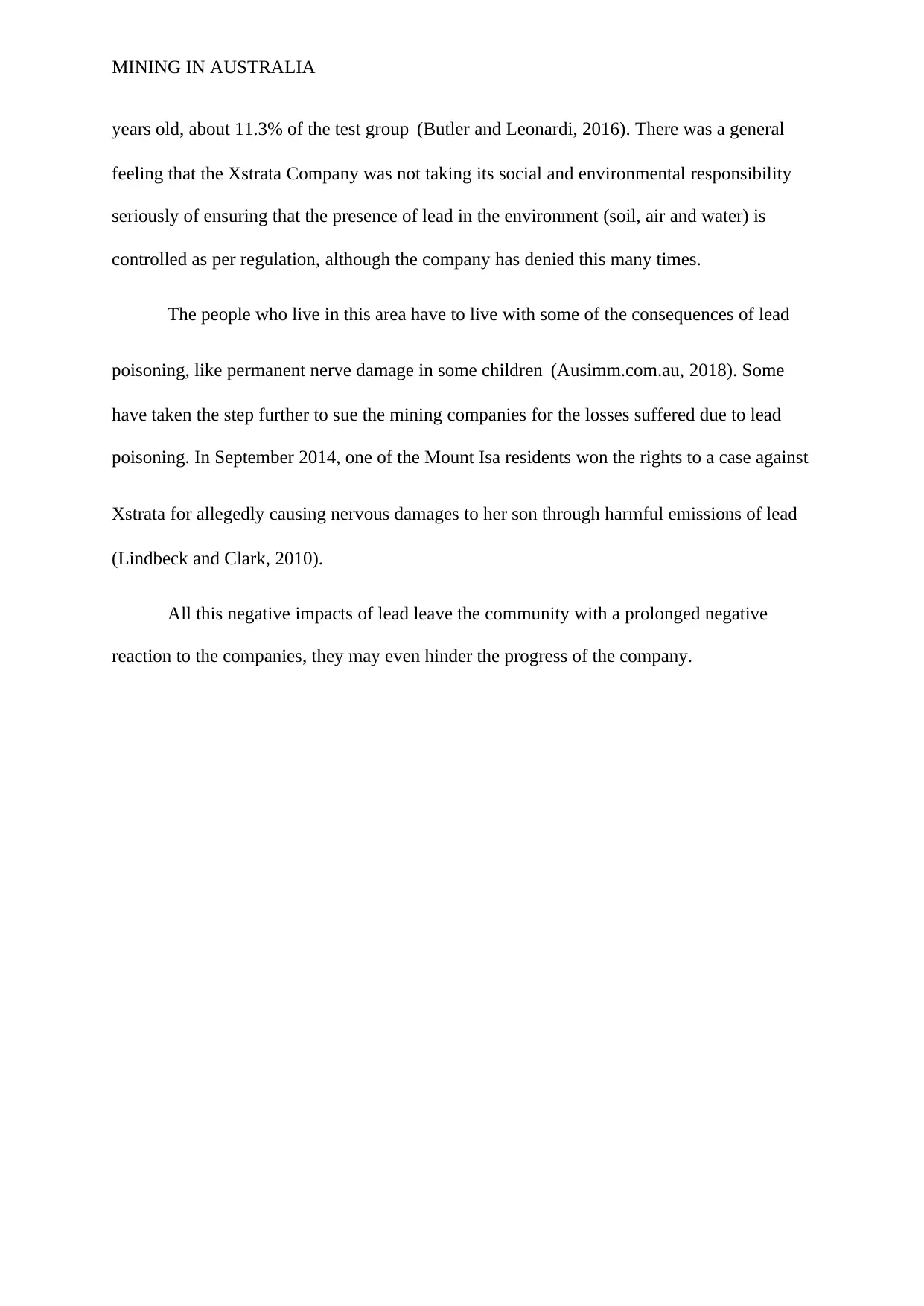
MINING IN AUSTRALIA
years old, about 11.3% of the test group (Butler and Leonardi, 2016). There was a general
feeling that the Xstrata Company was not taking its social and environmental responsibility
seriously of ensuring that the presence of lead in the environment (soil, air and water) is
controlled as per regulation, although the company has denied this many times.
The people who live in this area have to live with some of the consequences of lead
poisoning, like permanent nerve damage in some children (Ausimm.com.au, 2018). Some
have taken the step further to sue the mining companies for the losses suffered due to lead
poisoning. In September 2014, one of the Mount Isa residents won the rights to a case against
Xstrata for allegedly causing nervous damages to her son through harmful emissions of lead
(Lindbeck and Clark, 2010).
All this negative impacts of lead leave the community with a prolonged negative
reaction to the companies, they may even hinder the progress of the company.
years old, about 11.3% of the test group (Butler and Leonardi, 2016). There was a general
feeling that the Xstrata Company was not taking its social and environmental responsibility
seriously of ensuring that the presence of lead in the environment (soil, air and water) is
controlled as per regulation, although the company has denied this many times.
The people who live in this area have to live with some of the consequences of lead
poisoning, like permanent nerve damage in some children (Ausimm.com.au, 2018). Some
have taken the step further to sue the mining companies for the losses suffered due to lead
poisoning. In September 2014, one of the Mount Isa residents won the rights to a case against
Xstrata for allegedly causing nervous damages to her son through harmful emissions of lead
(Lindbeck and Clark, 2010).
All this negative impacts of lead leave the community with a prolonged negative
reaction to the companies, they may even hinder the progress of the company.
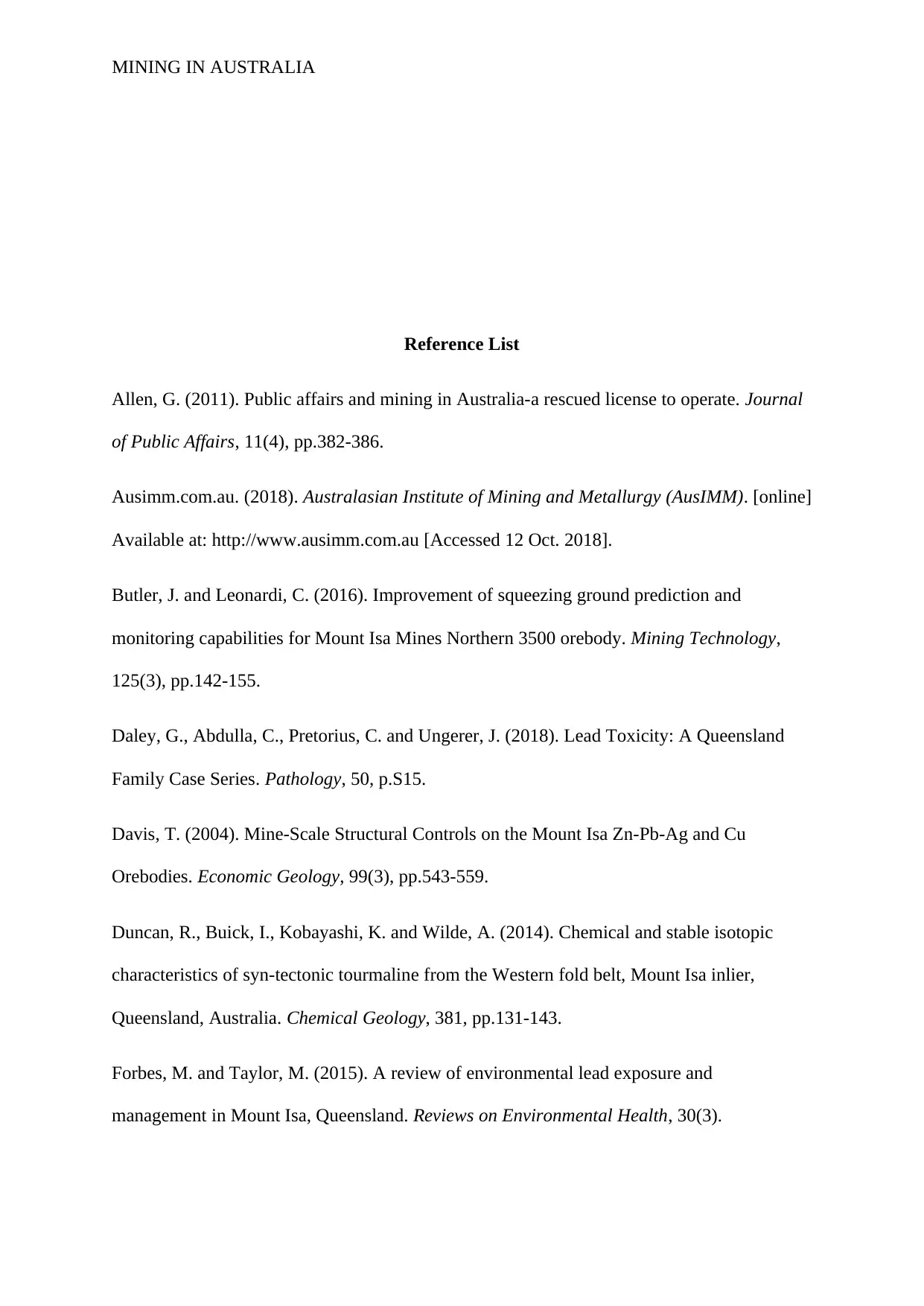
MINING IN AUSTRALIA
Reference List
Allen, G. (2011). Public affairs and mining in Australia-a rescued license to operate. Journal
of Public Affairs, 11(4), pp.382-386.
Ausimm.com.au. (2018). Australasian Institute of Mining and Metallurgy (AusIMM). [online]
Available at: http://www.ausimm.com.au [Accessed 12 Oct. 2018].
Butler, J. and Leonardi, C. (2016). Improvement of squeezing ground prediction and
monitoring capabilities for Mount Isa Mines Northern 3500 orebody. Mining Technology,
125(3), pp.142-155.
Daley, G., Abdulla, C., Pretorius, C. and Ungerer, J. (2018). Lead Toxicity: A Queensland
Family Case Series. Pathology, 50, p.S15.
Davis, T. (2004). Mine-Scale Structural Controls on the Mount Isa Zn-Pb-Ag and Cu
Orebodies. Economic Geology, 99(3), pp.543-559.
Duncan, R., Buick, I., Kobayashi, K. and Wilde, A. (2014). Chemical and stable isotopic
characteristics of syn-tectonic tourmaline from the Western fold belt, Mount Isa inlier,
Queensland, Australia. Chemical Geology, 381, pp.131-143.
Forbes, M. and Taylor, M. (2015). A review of environmental lead exposure and
management in Mount Isa, Queensland. Reviews on Environmental Health, 30(3).
Reference List
Allen, G. (2011). Public affairs and mining in Australia-a rescued license to operate. Journal
of Public Affairs, 11(4), pp.382-386.
Ausimm.com.au. (2018). Australasian Institute of Mining and Metallurgy (AusIMM). [online]
Available at: http://www.ausimm.com.au [Accessed 12 Oct. 2018].
Butler, J. and Leonardi, C. (2016). Improvement of squeezing ground prediction and
monitoring capabilities for Mount Isa Mines Northern 3500 orebody. Mining Technology,
125(3), pp.142-155.
Daley, G., Abdulla, C., Pretorius, C. and Ungerer, J. (2018). Lead Toxicity: A Queensland
Family Case Series. Pathology, 50, p.S15.
Davis, T. (2004). Mine-Scale Structural Controls on the Mount Isa Zn-Pb-Ag and Cu
Orebodies. Economic Geology, 99(3), pp.543-559.
Duncan, R., Buick, I., Kobayashi, K. and Wilde, A. (2014). Chemical and stable isotopic
characteristics of syn-tectonic tourmaline from the Western fold belt, Mount Isa inlier,
Queensland, Australia. Chemical Geology, 381, pp.131-143.
Forbes, M. and Taylor, M. (2015). A review of environmental lead exposure and
management in Mount Isa, Queensland. Reviews on Environmental Health, 30(3).
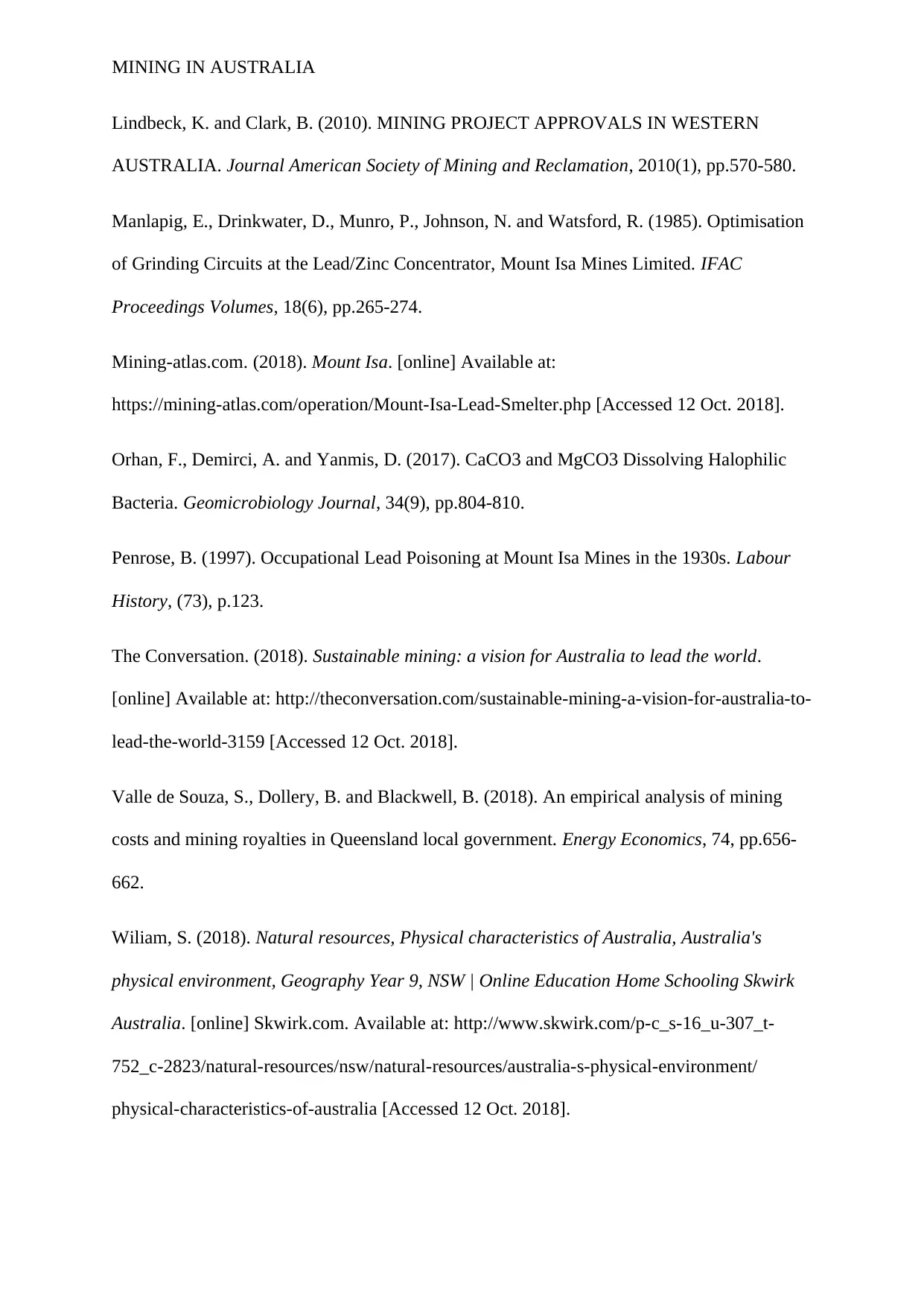
MINING IN AUSTRALIA
Lindbeck, K. and Clark, B. (2010). MINING PROJECT APPROVALS IN WESTERN
AUSTRALIA. Journal American Society of Mining and Reclamation, 2010(1), pp.570-580.
Manlapig, E., Drinkwater, D., Munro, P., Johnson, N. and Watsford, R. (1985). Optimisation
of Grinding Circuits at the Lead/Zinc Concentrator, Mount Isa Mines Limited. IFAC
Proceedings Volumes, 18(6), pp.265-274.
Mining-atlas.com. (2018). Mount Isa. [online] Available at:
https://mining-atlas.com/operation/Mount-Isa-Lead-Smelter.php [Accessed 12 Oct. 2018].
Orhan, F., Demirci, A. and Yanmis, D. (2017). CaCO3 and MgCO3 Dissolving Halophilic
Bacteria. Geomicrobiology Journal, 34(9), pp.804-810.
Penrose, B. (1997). Occupational Lead Poisoning at Mount Isa Mines in the 1930s. Labour
History, (73), p.123.
The Conversation. (2018). Sustainable mining: a vision for Australia to lead the world.
[online] Available at: http://theconversation.com/sustainable-mining-a-vision-for-australia-to-
lead-the-world-3159 [Accessed 12 Oct. 2018].
Valle de Souza, S., Dollery, B. and Blackwell, B. (2018). An empirical analysis of mining
costs and mining royalties in Queensland local government. Energy Economics, 74, pp.656-
662.
Wiliam, S. (2018). Natural resources, Physical characteristics of Australia, Australia's
physical environment, Geography Year 9, NSW | Online Education Home Schooling Skwirk
Australia. [online] Skwirk.com. Available at: http://www.skwirk.com/p-c_s-16_u-307_t-
752_c-2823/natural-resources/nsw/natural-resources/australia-s-physical-environment/
physical-characteristics-of-australia [Accessed 12 Oct. 2018].
Lindbeck, K. and Clark, B. (2010). MINING PROJECT APPROVALS IN WESTERN
AUSTRALIA. Journal American Society of Mining and Reclamation, 2010(1), pp.570-580.
Manlapig, E., Drinkwater, D., Munro, P., Johnson, N. and Watsford, R. (1985). Optimisation
of Grinding Circuits at the Lead/Zinc Concentrator, Mount Isa Mines Limited. IFAC
Proceedings Volumes, 18(6), pp.265-274.
Mining-atlas.com. (2018). Mount Isa. [online] Available at:
https://mining-atlas.com/operation/Mount-Isa-Lead-Smelter.php [Accessed 12 Oct. 2018].
Orhan, F., Demirci, A. and Yanmis, D. (2017). CaCO3 and MgCO3 Dissolving Halophilic
Bacteria. Geomicrobiology Journal, 34(9), pp.804-810.
Penrose, B. (1997). Occupational Lead Poisoning at Mount Isa Mines in the 1930s. Labour
History, (73), p.123.
The Conversation. (2018). Sustainable mining: a vision for Australia to lead the world.
[online] Available at: http://theconversation.com/sustainable-mining-a-vision-for-australia-to-
lead-the-world-3159 [Accessed 12 Oct. 2018].
Valle de Souza, S., Dollery, B. and Blackwell, B. (2018). An empirical analysis of mining
costs and mining royalties in Queensland local government. Energy Economics, 74, pp.656-
662.
Wiliam, S. (2018). Natural resources, Physical characteristics of Australia, Australia's
physical environment, Geography Year 9, NSW | Online Education Home Schooling Skwirk
Australia. [online] Skwirk.com. Available at: http://www.skwirk.com/p-c_s-16_u-307_t-
752_c-2823/natural-resources/nsw/natural-resources/australia-s-physical-environment/
physical-characteristics-of-australia [Accessed 12 Oct. 2018].
Paraphrase This Document
Need a fresh take? Get an instant paraphrase of this document with our AI Paraphraser
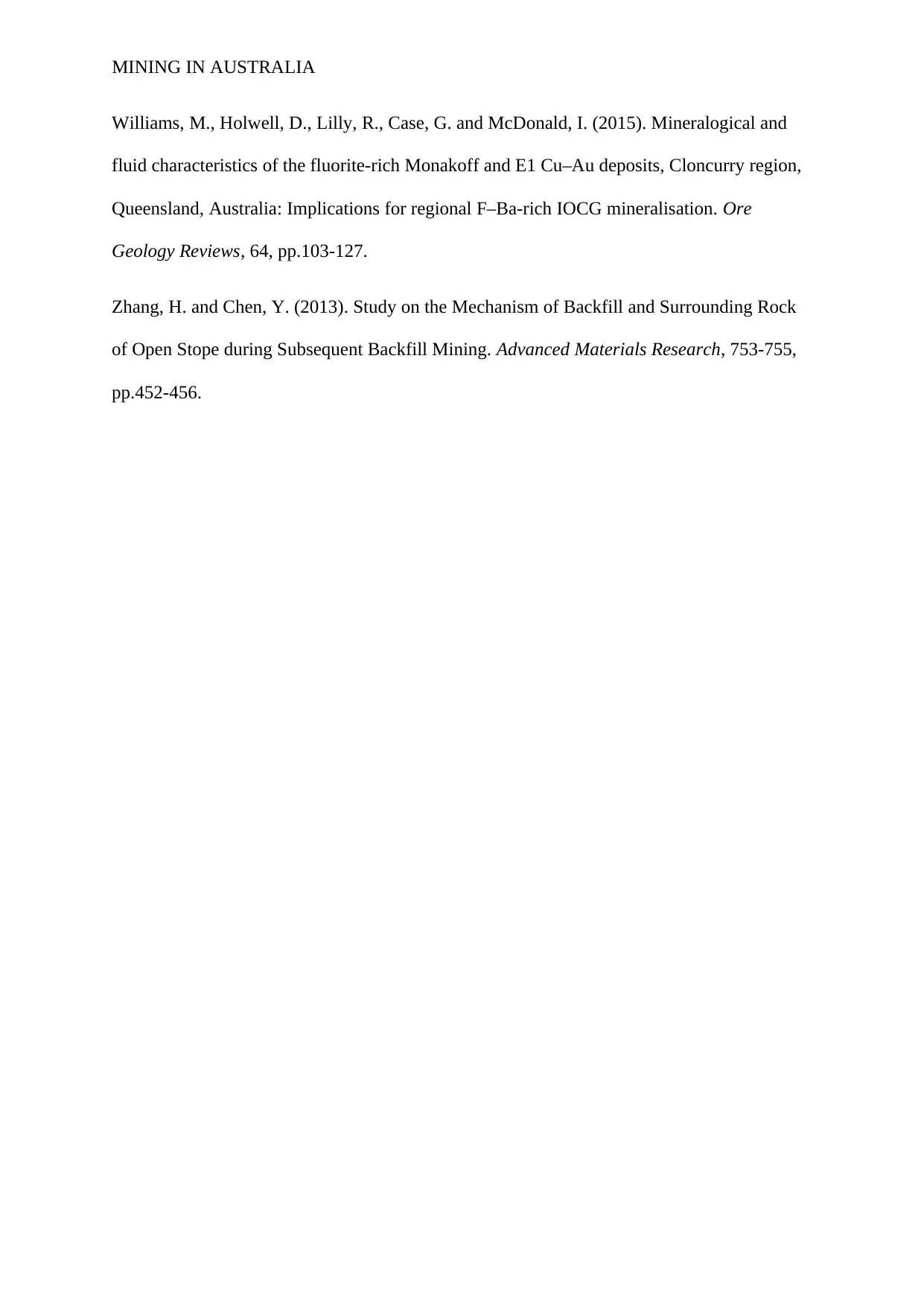
MINING IN AUSTRALIA
Williams, M., Holwell, D., Lilly, R., Case, G. and McDonald, I. (2015). Mineralogical and
fluid characteristics of the fluorite-rich Monakoff and E1 Cu–Au deposits, Cloncurry region,
Queensland, Australia: Implications for regional F–Ba-rich IOCG mineralisation. Ore
Geology Reviews, 64, pp.103-127.
Zhang, H. and Chen, Y. (2013). Study on the Mechanism of Backfill and Surrounding Rock
of Open Stope during Subsequent Backfill Mining. Advanced Materials Research, 753-755,
pp.452-456.
Williams, M., Holwell, D., Lilly, R., Case, G. and McDonald, I. (2015). Mineralogical and
fluid characteristics of the fluorite-rich Monakoff and E1 Cu–Au deposits, Cloncurry region,
Queensland, Australia: Implications for regional F–Ba-rich IOCG mineralisation. Ore
Geology Reviews, 64, pp.103-127.
Zhang, H. and Chen, Y. (2013). Study on the Mechanism of Backfill and Surrounding Rock
of Open Stope during Subsequent Backfill Mining. Advanced Materials Research, 753-755,
pp.452-456.
1 out of 14
Your All-in-One AI-Powered Toolkit for Academic Success.
+13062052269
info@desklib.com
Available 24*7 on WhatsApp / Email
![[object Object]](/_next/static/media/star-bottom.7253800d.svg)
Unlock your academic potential
© 2024 | Zucol Services PVT LTD | All rights reserved.